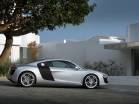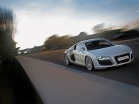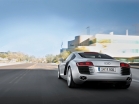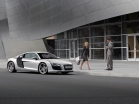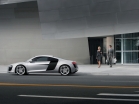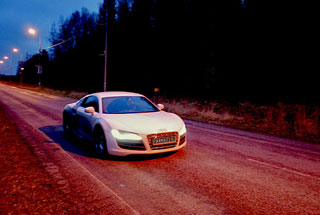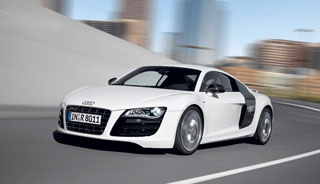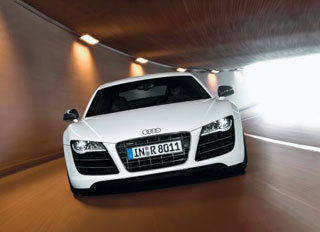Audi R8 V8 Test Drive since 2007 compartment
Compulsive test: Audi R8 V10 5.2 FSI, Porsche 911 Turbo
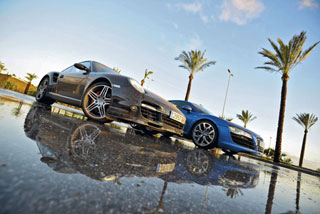 Be the best tiring. The pressure is too great - the hordes of enemies are attacked from all sides, leaving no time to respite. So 911 Turbo is overly corrupted by the eyes of his charisma, attracting the attention of dangerous predators. Shouting with diode headlights and shevel ten pistons, Audi R8 approached him at the distance of the blow
Be the best tiring. The pressure is too great - the hordes of enemies are attacked from all sides, leaving no time to respite. So 911 Turbo is overly corrupted by the eyes of his charisma, attracting the attention of dangerous predators. Shouting with diode headlights and shevel ten pistons, Audi R8 approached him at the distance of the blow Let's start with two news. First. Since its debut in 2007, the Audi R8 has spread around the world with a circulation of almost 10 thousand copies. The second. He does not even think to stop there, gaining strength before the assault on new heights. The Germans abandoned shock therapy in favor of good old surgery: a 10-cylinder engine has just been implanted to the car, which they have been expected from Audi for a long time. In terms of technology, the Audi R8 now diligently copies Lamborghini Gallardo, which raises an acute question to life: what's the point? Are the wise strategists of the Volkswagen group played into the troubles of Engineering?
Confessing the cult of comfort, the Audi R8 with its physique of the sports car gravitates more to the Gran Turismo cars. And in this class there is a universally recognized standard - Porsche 911 Turbo, great and terrible. Terrible to rivals, wonderful for the owner. The ideological aspect brings the R8 V10 and 911 Turbo: they are positioned as the faces of their brands - super -speed machines with easy control, exemplary safety level and powerful service support for the manufacturer. But structural differences are obvious: take at least the rear -wheel drive 911 Turbo and the all -wheel drive transmission R8. Whose truth will prevail? The logic of things dictates the inevitability of a cruel duel between these machines.
Wet business
Thursday, 12 o’clock in the afternoon. The outskirts of the Spanish Malaga flood pouring rain. In such extreme conditions, the Audi R8 presentation with a 5.2-liter engine for representatives of the international automobile press begins. The truth is, trying to draw conclusions about the running qualities of the car is stupid: 525 hp. Under the right foot cannot be felt for the proper support. I said 525? Gracious God! Fifteen years ago, from this figure it would have darkened in the eyes and shook the flaws. The curbing of such power was akin to the detection and deactivation of anti -personnel mines. At that time, Porsche 911 Turbo was equipped with a 3.6-liter boxer with a return of 360 hp, and not everyone was decided to sit behind the steering wheel. Today, other times have come, and the capabilities of cars have expanded phenomenally. I am convinced of this again when the Audi R8, working frantically by janitors, rushes along the water surface of the asphalt like drugs. The 911 Turbo rushes towards the rain and the views of Audi employees between the supports of the overpass.
As it turns out, the fundamental difference between the Germans lies not only in the type of drive. The V10 engine is filled with advantages, but they are ready to demonstrate them with access to the high -speed zone. The opponent Porsche, on the contrary, tears literally with idle. There is enough accurate touch to the accelerator to accurately determine which of the cars is in your hands.
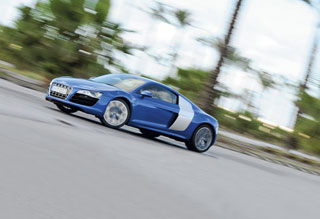 It is curious that the temperament of the 10-cylinder Audi R8 unit is greatly resembled by the base 8-cylinder 4.2-liter. Outwardly, the two modifications are easiest to distinguish in the form of side air intakes: in the younger version they are flattened, the older is protruded. There are other innovations: 19-inch wheels with Y-shaped knitting needles, a chrome radiator grille and elliptical exhaust pipes.
It is curious that the temperament of the 10-cylinder Audi R8 unit is greatly resembled by the base 8-cylinder 4.2-liter. Outwardly, the two modifications are easiest to distinguish in the form of side air intakes: in the younger version they are flattened, the older is protruded. There are other innovations: 19-inch wheels with Y-shaped knitting needles, a chrome radiator grille and elliptical exhaust pipes. It would be incorrect to say that one car is more beautiful than another. This is a matter of individual preferences. We can only share our own observations. Of course, Audi is striking - there are still few such cars, and they look first -class. But Porsche, who does not have enough catchy anti -wingeds to maintain the image of a bad guy, radiates charm, captivating experts and ignorant profiles. The 10-cylinder R8 interior can be found by red edges of the devices, otherwise it thoroughly repeats the less powerful modification. But we are not offended, because we love the R8 for the atmosphere of comfort, quality and style - the set that is obliged to possess each car of the GT category. In general, Audi seems to be the limit of dreams, but only until you find yourself in 911 Turbo, where infallible ergonomics and exquisite design reign. And yet we want to return to the R8 again to mark an important detail. None of the Grandes of the German Auto Industry managed to distance himself in his top models so cleverly from the taste of mass, as Audi succeeded. For example, the BMW M6 interior is nothing more than a variation on the M5 theme, and the Mercedes CL 63 AMG practices motives dictated by the S-class. And a completely different story is Audi R8, which does not give reasons to suspect him in kinship with RS6.
Yes, the guys from Ingolstadt succumbed to the sin of vanity. The cover of the motor compartment is almost entirely made of glass, under which V10 with direct fuel injection FSI is put on public display. Meshcinism, of course, but with its own highlight. Well, the Porsche engine driven by a pair of turbines has to admire by ear, here without options. The numbers, alas, are unknown emotions - 480 -horsepower 911 Turbo are weaker than R8 V10 by 45 hp, which promises consequences. Dressing? However, before drawing conclusions, you should study the curves of torque. It immediately turns out that the peak of the Porsche biturboat traction falls on 1950 rpm and it reaches a value of 620 nm (in the SPORT mode - 680 nm at 2100 rpm), while Audi is capable of 530 nm, and even then after reaching 6500 about /min! And how, in your head, everything went on the shelves again? Wait a little. Let us recall that the 5.2-liter R8 engine is borrowed from Gallardo LP 560-4 and the genes he carries the most racing. The high -speed engine has retained the lubricant with a dry card and adjustable phases of gas distribution, but reconfiguration of the power system, the intake manifold and the exhaust system led to a decrease in recoil from 560 to 525 hp.
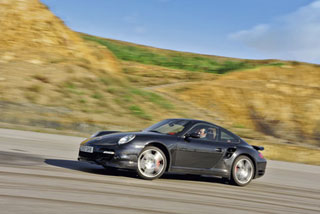 Robotized gearbox R Tronic installed on Audi is called E-Gear, which, in fact, the differences and are exhausted. Of course, the Germans reprogrammed it in the direction of mitigating work - in particular, the Sport mode for R8 corresponds to the Normal mode for Gallardo. If we talk about 911 Turbo, then it is equipped with the most common, albeit brought to brilliant condition by the Tiptronic S. Clear business, it deprives the driver of a greater share of control over the machine than the robot. Although there are claims to the latter - first of all, due to excessive sharpness of switching. I must admit, R Tronic is more clearly and faster, but the Tiptronic S is an order of magnitude more comfortable.
Robotized gearbox R Tronic installed on Audi is called E-Gear, which, in fact, the differences and are exhausted. Of course, the Germans reprogrammed it in the direction of mitigating work - in particular, the Sport mode for R8 corresponds to the Normal mode for Gallardo. If we talk about 911 Turbo, then it is equipped with the most common, albeit brought to brilliant condition by the Tiptronic S. Clear business, it deprives the driver of a greater share of control over the machine than the robot. Although there are claims to the latter - first of all, due to excessive sharpness of switching. I must admit, R Tronic is more clearly and faster, but the Tiptronic S is an order of magnitude more comfortable. main news
The limit to which the Audi engine can spin, 8700 rpm, and for a bulky multi -cylinder unit is a real achievement. The speed of rotation of a more compact opponent Porsche is 2000 rpm less. Here is an explanation why it is exhausted much earlier. The R8 motor is less elastic, and its bottom is poorer. It feels like in such modes it is hardly preferable to the base 4.2-liter eight. The engine longs to spin, and it has to twist it generously, reveling in the exponential increase in traction. This behavior is characteristic of all aggregates of the V10 configuration - except that it is installed on Dodge Viper. I do not think that it fits into the philosophy of a representative sedan like Audi S8, but the sports car suits perfectly. In the end, these machines are created in order to stick the tachometer arrow over and over again, the red -hot sector of the scale is reddened, listen to the grassening howl of an angry motor and feel that there is happiness in life. To exist differently, it soon becomes unacceptable. But what about Porsche? Will he withstand similar passions? After all, he will have to strain in earnest with his 3.6 liters! The first acceleration into the floor plunged into amazement - how did they achieve such agility, having 480 hp with a capacity of 480 hp? Incredible!
Firstly, Porsche is always responsible for every horsepower of power and knows how to productively exploit it. Meaningless losses are excluded. Secondly, the patented TGV technology, which allows you to change the geometry of turbines, provides the most efficient operation of the motor in the entire range, from idle up to 6000 rpm. So engineers from Vaisakh create the illusion of the inexhaustment of the energy of the car, endowing it with the ability to briskly increase the intensity of acceleration in any modes. At the emotional level 911 Turbo shows passion with elements of animal rudeness. But for dynamism he wants to forgive everything.
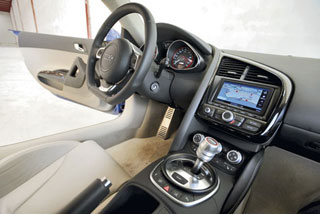 Unfortunately, we did not have the opportunity to instrumentally check the technical data declared by manufacturers. But a series of parallel starts led us to the belief that it would be unrealistic to identify the winner without a photorenic. The acceleration time from a place to 100 km/h in both cars is identical - 3.9 s. If you select 911 Turbo with a manual transmission, and not with an automaton, it will be reduced to 3.7 s, which will slightly violate the balance. The speed of 200 km/h Audi is gaining 12.8 s 12.8 s. The difference is subtle. By the way, the 8-cylinder R8 accelerates to hundreds of 4.6 s, yielding 0.8 with modification V10 5.2 FSI. The maximum speed for Turbo is 310 km/h, for 10 -cylinder R8 - 316 km/h, despite the fact that the Ferrari F430 is able to develop 315 km/h. But Ferrari is a topic for a separate conversation.
Unfortunately, we did not have the opportunity to instrumentally check the technical data declared by manufacturers. But a series of parallel starts led us to the belief that it would be unrealistic to identify the winner without a photorenic. The acceleration time from a place to 100 km/h in both cars is identical - 3.9 s. If you select 911 Turbo with a manual transmission, and not with an automaton, it will be reduced to 3.7 s, which will slightly violate the balance. The speed of 200 km/h Audi is gaining 12.8 s 12.8 s. The difference is subtle. By the way, the 8-cylinder R8 accelerates to hundreds of 4.6 s, yielding 0.8 with modification V10 5.2 FSI. The maximum speed for Turbo is 310 km/h, for 10 -cylinder R8 - 316 km/h, despite the fact that the Ferrari F430 is able to develop 315 km/h. But Ferrari is a topic for a separate conversation. The Audi body is built around a spatial aluminum frame, which promises a double decrease in mass compared to the steel structure. As a result, the R8 V10 turned out to be 35 kg heavier than 911 Turbo. How so? The following facts make clarity. An additional pair of cylinders entailed an increase in the mass of R8 by 60 kg: an increase of 31 kg gave a power unit, another 29 kg - auxiliary equipment. Despite this, the distribution of mass along the axes remains the same: 44% per front and 56% per stern. What is Turbo? The commitment of the rear -engine layout is not in vain - 39:61 in favor of the drive wheels. In this way, Porsche traditionally solves the problem of loading the leading axis, which is fundamentally important for the maximum realization of the engine potential during acceleration. Audi has its own fetish - Quattro all -wheel drive. In the case of R8, we are talking about using the same scheme as Gallardo. Here, the torque is transmitted to the front axle through the WISKOFTA, and a self -locking differential is used from behind. A similar differential is proposed for 911 Turbo, but only in the option with the manual transmission. This is a clear example of diversification of the model range.
Under standard conditions, the Audi rear wheel wheel receive 90% engine thrust, which determines the striking difference in R8 habits from TT. And even more so from Porsche. The all -wheel drive R8 behaves more stable both on public roads and on the track. In the same
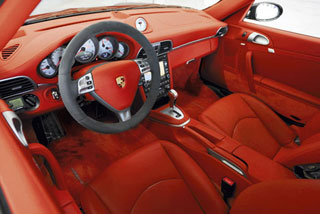 situations 911 Turbo requires a special delicacy from the driver - a short wheelbase and a motor in the rear overhang are just waiting for errors in piloting in order to translate the progressive movement into the rotational. Audi safety for a good half is guaranteed by linearity and predictability of reactions. But if you choose the key to Porsche, find a common language with it, it will expand the horizons of controllability and coating clutch, surpassing any expectations. Inhibition is impressive no less than acceleration, but this is only the initial level. Lists of options are attached to both cars, which mention carbon-ceramic brake discs. Their advantages include more accurate and quick response to the displacement of the pedal, which means the ability to precisely dose the brake force. In addition, such discs are durable, although their survivability directly depends on the driving manner. Frequent trips to the racing highway will exclude their chances to reach 300 thousand km for which ceramics are designed. This applies to both Audi and Porsche.
situations 911 Turbo requires a special delicacy from the driver - a short wheelbase and a motor in the rear overhang are just waiting for errors in piloting in order to translate the progressive movement into the rotational. Audi safety for a good half is guaranteed by linearity and predictability of reactions. But if you choose the key to Porsche, find a common language with it, it will expand the horizons of controllability and coating clutch, surpassing any expectations. Inhibition is impressive no less than acceleration, but this is only the initial level. Lists of options are attached to both cars, which mention carbon-ceramic brake discs. Their advantages include more accurate and quick response to the displacement of the pedal, which means the ability to precisely dose the brake force. In addition, such discs are durable, although their survivability directly depends on the driving manner. Frequent trips to the racing highway will exclude their chances to reach 300 thousand km for which ceramics are designed. This applies to both Audi and Porsche. We believe you want to hear the verdict: 911 Turbo or R8 V10? Well, listen. Even having made the engine from Lamborghini at his disposal, the Audi R8 could not shake the position of 911 Turbo, which was as it was and remained icon of the GT class. But the R8 is not just sitting in its niche, it is actively progressing. Its rapid evolution does not allow us to talk more about the dynamic qualities of 911 Turbo as something exception. And this, perhaps, today will be news number one.
Specifications
Audi R8 V10 5.2 FSI
Porsche 911 Turbo
Dimensions, mm
4435x1930x1252
4450x1852x1300
Base, mm
2650
2350
Equipped mass, kg
1620
1585
engine's type
gasoline v10
b6 gasoline with turbocharged
Working volume, cubic meter. cm
5204
3600
Max. Power, L.S./rpm
525/8000
480/6000
Max. moment, nm/rpm
530/6500
620/1950-5000
Transmission
mechanical 6-speed
robotized 6-speed
Drive unit
full
rear
Max. speed, km/h
316
310
Acceleration time 0100 km/h, with
3,9
3,9
Fuel consumption (average), l/100 km
13,7
no data
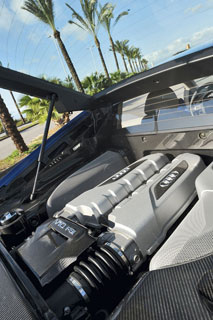
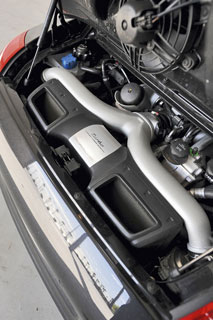
Laurent Chevalier
Photo by Loran Willaron
Mondadori Magazines France, Sport Auto
Source: Avtopanorama magazine

